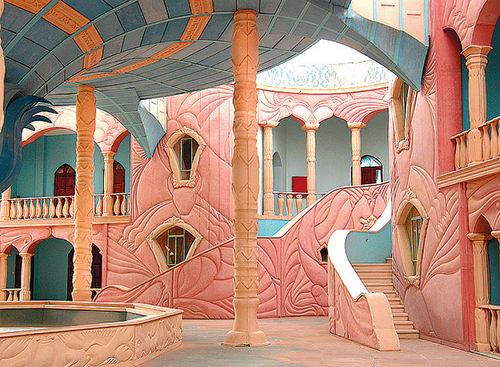


Kibbutz Neot Semadar is best known for its array of organic products grown and prepared on the kibbutz and as “that place with the weird, colorful tower sticking up in the sky in the middle of nowhere.”
Anyone who has driven along Route 40 in the Arava region will have seen Neot Semadar’s famous landmark. Taking the time to veer off the main highway to tour the kibbutz is an opportunity many miss—most of the time, because they just don’t know about it. Most of those who do stop at the Road 12-Route 40 junction that leads to Eilat buy a snack at the kibbutz-run organic café Pundak Neot Semadar—one of a growing number of refueling stops along Route 40. The café sells the different products grown and made on the kibbutz, including organic cheeses and jams and wines, as well as arts-and-crafts items.
The most eye-catching aspect of the kibbutz is the Arts Center—a Willy Wonka-type wondrous building with a pink-and-blue tower rising above it that looks totally out of place in the area, yet magically fits perfectly. “It’s an amazing place to visit from its visual perspective. The Arts Center is known as the Taj Mahal of the Middle East. There are amazing desert views and a sensory experience of taste and smell,” says Shaul. “The story of the community is also important. It’s a place of education. We run many seminars and workshops for people wanting to learn about themselves.”
Sustainable Desert Architecture
The strange-looking Arts Center tower is actually a passive cooling tower, an ecologically friendly heating/cooling system. Members of the kibbutz dedicated 15 years to building the Arts Center and the tower through a process of research, trial and error. “My parents would ask, ‘Is it done yet?’ when we were building it,” Shaul relates. “Every year that passed, they would ask again.”
Whereas no one in their right mind would pay a contractor to construct a building over the course of 15 years, the Neot Semadar kibbutz members had taken on this project as a challenge to finding new desert architecture. They read up on ancient Middle Eastern building techniques and sustainable architecture. Though it took them a long time to finish the project, along the way they ended up creating a new technique for which they would become celebrated. Today, the Neot Semadar Academy passes along the skills of building eco-friendly structures and the basics of construction. In fact, the Waldorf-Astoria in Jerusalem turned to this kibbutz’s crafts people for their expertise in glass fiber-reinforced concrete for intricate details and complex geometries.
Behind-the-Scenes Tour
Standing on the top balcony of the Arts Center, one is afforded panoramic views of the desert around. The postcard-perfect vistas include the date plantation below, the mud-brick houses for which the kibbutz is well known, the free-range goat herds, the organic vegetable gardens and the fruit tree orchards.
There are 90 adults, 70 children and 50 volunteers—from all over the world—living and working on the kibbutz.
Tours of Neot Semadar (which must be booked ahead) take visitors behind the scenes. The Arts Center is the central point of the community. The tour starts here and gives visitors an up-close look at the intricate designs of the building and banisters, as well as one of the artists’ workshops. There is time to browse at the shop selling crafts made by kibbutz members. Walk up the stairs to a photographic exhibit showing the history of the building.
From the Arts Center, visitors walk through the organic garden patch, past the goat pen, through a garden watered by the community’s own water-recycling techniques, to the cheese-making factory and over to the wine shop/bar for tasting. The boutique winery’s vineyards represent the southernmost grape cultivation in Israel. Though the desert may not seem like a prime grape-growing environment, visitors will find it difficult not to buy at least one bottle of these award-winning wines after a tour.
The kibbutz members know they have something special to offer the Israeli tourism landscape, and they run workshops and courses for people who want to stay and learn more after their initial two-hour tour comes to an end.
To book a visit: visit@neot-semadar.com.
By Viva Sarah Press, Israel 21c











